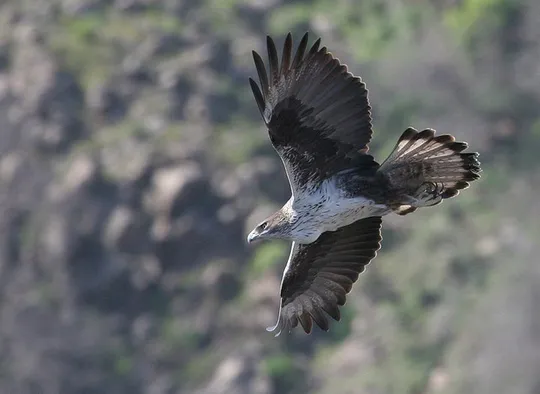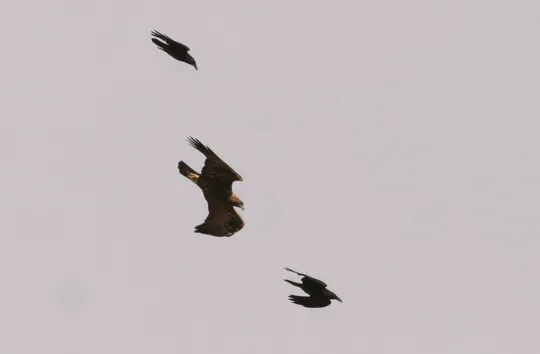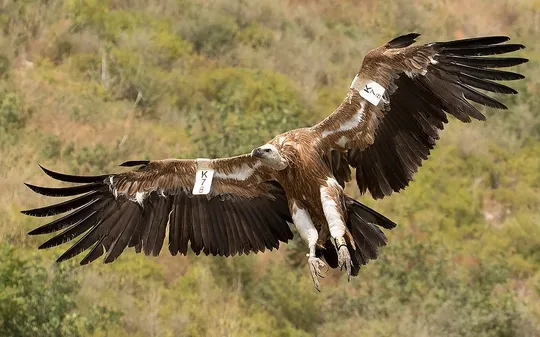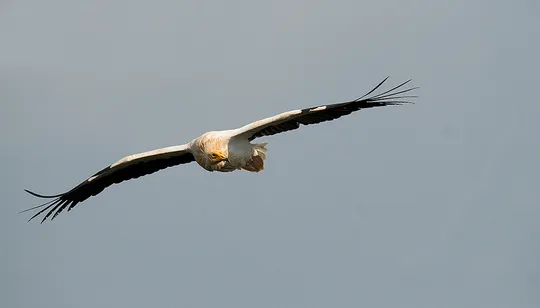Haliaeetus albicilla
 Critically Endangered
Critically Endangered
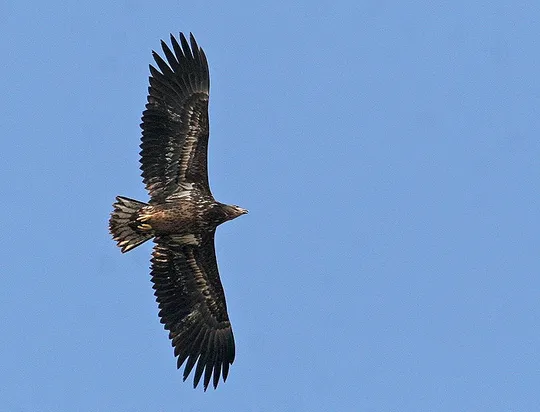
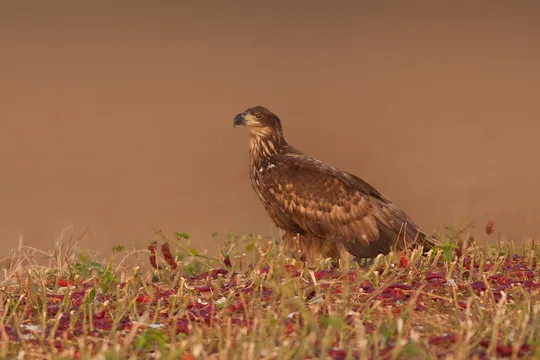
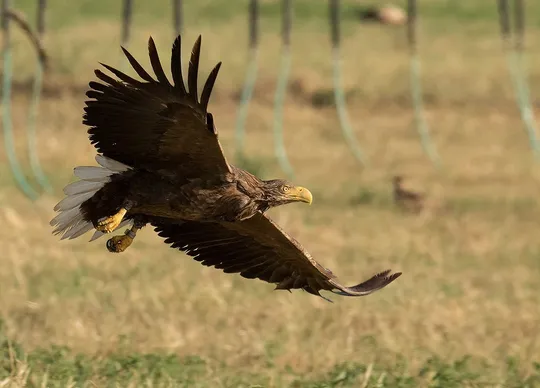
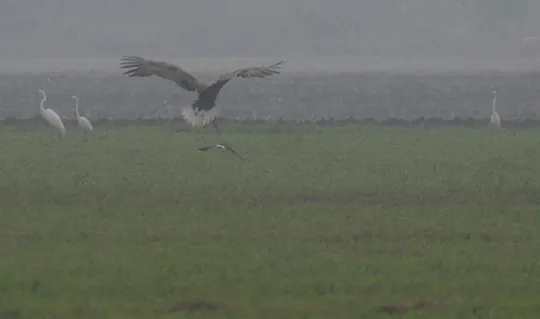
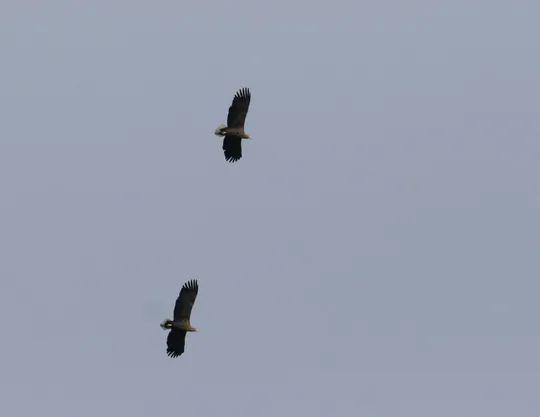
| Habitats | Wetland Thickets, Humid Lowlands |
|---|---|
| Presence In Israel | Winter Visitor, Resident |
| Breeding In Israel | Breeder |
| Migration Types | Resident |
| Zoographical Zones | Mediterranean |
| Landscape Types | Plains & Valleys, Wetlands, Fresh Water, Marsh |
| Vegetation Densities | Medium, High |
| Nest Locations | Tree |
| Diet Types | Carrion, Fish |
| Foraging Grounds | Water, Ground |
| Body Sizes | Large (over 1000g) |
| Threat Factors | Electrocution and collision with transmission wires, Pesticide Poisoning, Lead Poisoning, Wetland Drainage & Pollution |
The White-tailed Sea-eagle is a large heavy bird of prey, the largest in Israel that is not a scavenger. It has dark brown plumage, a grey head, a large yellow beak and a short wedge-shaped tail. Inhabits wetlands, such as lakes, seashores, pools and reservoirs. Feeds mainly on fish that it catches close to the water surface from shallow dives, as well as on dead fish, waterbirds and small mammals.
Two pairs of White-tailed Sea-eagles nested in the Hula Valley and the Mt. Gilboa slopes until 1957, when breeding in Israel ceased (Paz 1986, Shirihai 1996). About 50 birds have been released from the captive breeding nucleus at the Carmel Hai Bar since 1991, some of which survived for a few years following release and one pair has been breeding successfully in the Hula Reserve since 2015. In addition, immature birds from Eastern European populations appear sporadically in Israel during migration and winter. They are seen mainly in the southern Golan Heights, Northern Valleys and the Judean Lowlands.
Valleys and moist, fertile flatlands with water bodies and tall trees. Usually nests on trees.
A number of White-tailed Sea-eagle pairs bred in Israel until the mid-20th century. Breeding ceased in the wake of the Hula Lake drainage and excessive use of agricultural pesticides. The juvenile sea eagles released in recent decades from the breeding nucleus are harmed mainly by electrocution, pesticide poisoning, as well as by hunting and trapping, particularly when they wander outside Israel’s borders.
The White-tailed Sea-eagle became extinct as a breeder in the 1950s. Since 1991 it is being reintroduced to nature. In recent years there is one pair nesting in the Hula Reserve every year, while at the same time immature birds continue to be released from the breeding nucleus.
The White-tailed Sea-eagle is classified as Critically Endangered (CR) because of the extremely small size of its breeding population in Israel. In the previous edition of the Red Book (2002), it was classified as Regionally Extinct (RE). The improvement in its threat category reflects the improvement in the population, which has returned to breed in Israel after a long interval, as a result of the reintroduction project.
The reintroduction project should be continued until the goal of five breeding pairs throughout the valleys in northern Israel is accomplished (Hatsofe & Mayrose 2015, Master Plan for Raptor Conservation in Israel).
- הצופה, א., קפלן, א. ואורון, ט. 2002. השבת העיטמים לבני זנב לטבע בישראל. העזניה 31, הוצאת טבע הדברים והחברה להגנת הטבע.
- סלע, י. 1975. סקר העופות הדורסים 1970–1975. אוניברסיטת תל-אביב: המכון לחקר שמירת הטבע.
- פז, ע. 1986. עופות. מתוך אלון, ע. (עורך), החי והצומח של ארץ ישראל. כרך 6. הוצאת משרד הביטחון, ישראל.
- Mendelssohn, H. 1972. The impact of pesticides on bird life in Israel. ICBP 11:75-104.
- Shirihai, H., 1996. The Birds of Israel. Academic Press, London.
- Symes, A. 2013. Species generation lengths. Unpublished, BirdLife International.
- Species page at Birdlife International
Current Occupancy Map
| Data Missing | Sporadic | Limited Sites | Low Density | High Density |
|---|---|---|---|---|
| 0 | 0 | 0 | 0 | 0 |
Distribution maps
The maps presented here provide visual information on the distribution of species in Israel from the past and present, and the changes in occupancy and breeding density during the comparison period. For further reading
Relative Abundance 2010-2020
Breeding density values in the current decade as determined from experts' opinion and observations from databases.
| Data Missing | Sporadic | Limited Sites | Low Density | High Density |
|---|---|---|---|---|
| 8 | 12 | 12 | 21 | 19 |
Relative Abundance 1980-1990
Density values based primarily on the book The Birds of Israel (Shirihai 1996).
| Data Missing | Sporadic | Limited Sites | Low Density | High Density |
|---|---|---|---|---|
| 5 | 14 | 14 | 17 | 22 |
Occupancy 1990-2020
The map shows differences in the species breeding distribution between the 1980's breeding map and the current weighted breeding evaluation. Negative value - species previously bred in the grid and is not presently breeding; positive value - species has not previously bred in the grid and is currently breeding.
| Data Missing | No Change | Occupancy Increase | Occupancy Decrease |
|---|---|---|---|
| 6 | 35 | 1 | 9 |
Change in Relative Abundance 1990-2020
The map shows the changes in the relative abundance of a species in each of the distribution grids between the breeding map of the 1980s and the weighted current breeding evaluation. Negative values - decline in abundance; positive values - increase in abundance; zero - no change in abundance.
| 80 to 100 | 50 | 20 to 30 | No Change | 30- to 20- | 50- | 100- to 80- | Data Missing |
|---|---|---|---|---|---|---|---|
| 0 | 4 | 2 | 22 | 12 | 14 | 11 | 16 |
| Rarity | |
|---|---|
| Vulnerability | |
| Attractiveness | |
| Endemism | |
| Red number | |
| Peripherality | |
| IUCN category | |
| Threat Definition according to the red book |
 Contributed:
Contributed: 